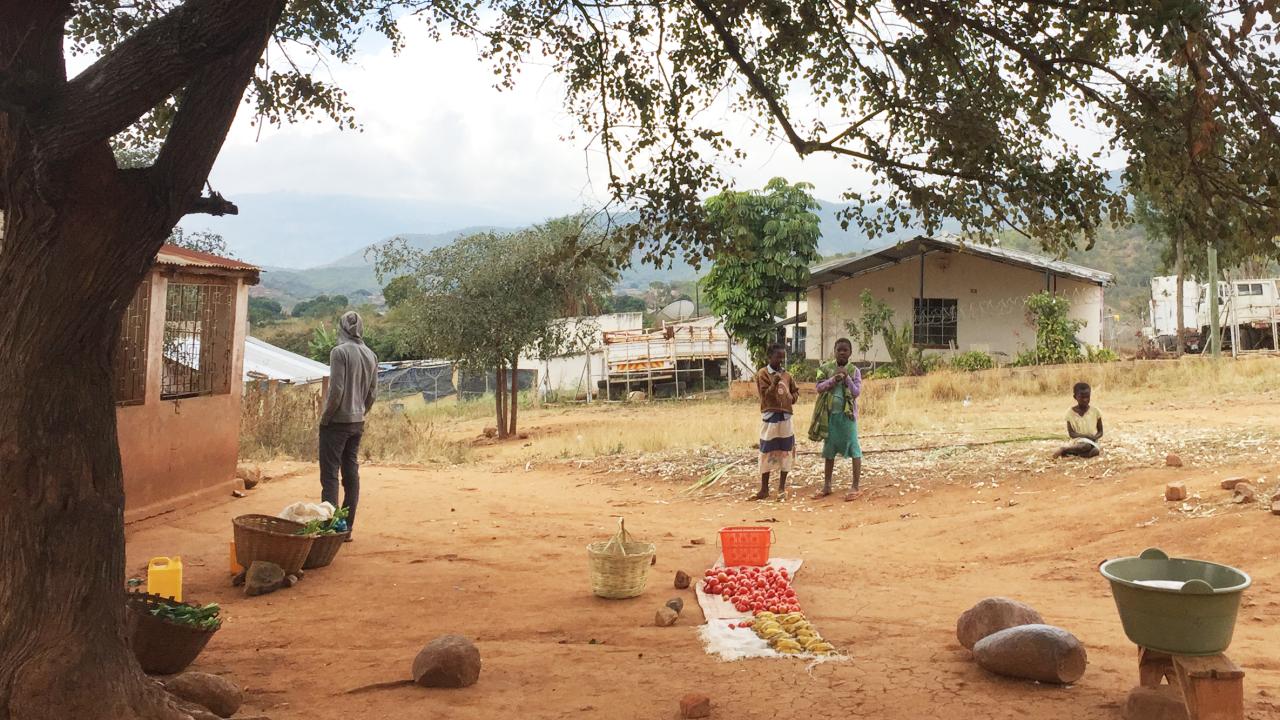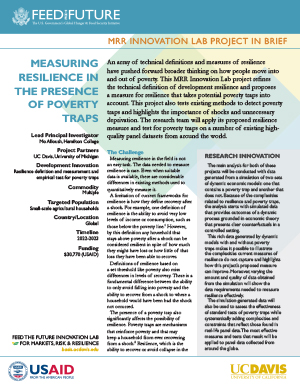
An array of technical definitions and measures of resilience have pushed forward broader thinking on how people move into and out of poverty. This MRR Innovation Lab project refines the technical definition of development resilience and proposes a measure for resilience that takes potential poverty traps into account. This project also tests existing methods to detect poverty traps and highlights the importance of shocks and unnecessary deprivation. The research team will apply its proposed resilience measure and test for poverty traps on a number of existing high-quality panel datasets from around the world.
Project Overview
Lead Principal Investigator: Mo Alloush, Hamilton College
Project Partners: UC Davis, University of Michigan
Development Innovation: Resilience definition and measurement and empirical test for poverty traps
Commodity: Multiple
Targeted Population: Small-scale agricultural households
Country/Location: Global
Timeline: 2022-2023
Funding: $30,770 (USAID)
The Challenge
Measuring resilience in the field is not an easy task. The data needed to measure resilience is rare. Even when suitable data is available, there are considerable differences in existing methods used to quantitatively measure it.
A limitation of current frameworks for resilience is how they define recovery after a shock. For example, one definition of resilience is the ability to avoid very low levels of income or consumption, such as those below the poverty line.1 However, by this definition any household that stays above poverty after a shock can be considered resilient in spite of how much they might have lost or how little of that loss they have been able to recover.
Definitions of resilience based on a set threshold like poverty also miss differences in levels of recovery. There is a fundamental difference between the ability to only avoid falling into poverty and the ability to recover from a shock to where a household would have been had the shock not occurred.
The presence of a poverty trap also significantly affects the possibility of resilience. Poverty traps are mechanisms that reinforce poverty and that may keep a household from ever recovering from a shock.2 Resilience, which is the ability to recover or avoid collapse in the face of shocks,3 may be hampered if a poverty trap is present. However, there is continued debate about whether it is possible to empirically identify poverty traps in complex settings and even whether or not they exist.

Research Design
This MRR Innovation Lab project aims to further our understanding of development resilience and its measurement. This project also incorporates the complexities that poverty traps would present. Moreover, the project tackles the difficulties in detecting poverty traps with observational data. The effectiveness of different measures of resilience and tests for poverty traps will be assessed using simulation-generated data and then applied to high-quality panel datasets from around the world.
The data to validate various measures of resilience and tests for poverty traps is generated from a simulation of two sets of dynamic economic models, one with a poverty trap and the other without one. This data includes all the complexities of resilience and poverty traps but in a controlled setting in which to estimate the impacts of shocks in multiple scenarios.
This project’s definition of resilience is the ability to quickly recover from a shock to the same level of income as if there had been no shock at all. This definition clearly differentiates between levels of recovery, which can show a development program’s comparable ability to support recovery from shocks.
This project overcomes some of the challenges of detecting poverty traps with survey data using standard empirical methods when there are realistic complexities, such as people having different abilities, or common statistical challenges. This project will also provide guidelines of the data requirements needed to accurately test for poverty traps in complex settings where people have varying sources of income and levels of assets and ability, and will differentiate between unnecessary deprivation and differences based on people’s preferences or personal characteristics.
This project runs parallel to a randomized controlled trial (RCT) of a community health program in Mozambique that is collecting panel data on households who were affected by Cyclone Idai in 2019. This project’s methods on resilience and poverty traps will be used to measure the effectiveness of the community health program at improving household resilience.
Development Impact
This project has policy implications anywhere poverty and economic vulnerability exist. An accurate measure of resilience and a reliable test for poverty traps make it possible to target social programs to the most vulnerable communities.
This project contributes significantly to efforts to empirically identify poverty traps with survey data from settings more complex than where households rely on a single source of income. Recent evidence from Bangladesh[4] has renewed debate about the existence of poverty traps in complex settings.
This project also has implications for inequality in rich countries in which a poverty trap can perpetuate inequality and reduce mobility. In developing countries, poverty traps are usually modeled as a fixed cost that acts as a barrier to more productive agricultural technologies like fertilizer. In a country like the U.S., this up-front cost would be a college degree.[5]
[1] Cisse, J., et al. 2018. “Estimating development resilience: A conditional moments-based approach.” Journal of Development Economics.
[2] Barrett, C., et al. 2013. “The economics of poverty traps and persistent poverty: Empirical and policy implications.” Journal of Development Studies.
[3] Barrett, C., et al. 2014. “Toward a Theory of Resilience for International Development Applications.” Proceedings of the National Academy of Sciences.
[4] Balboni, C., et al. 2021. “Why do people stay poor?” National Bureau of Economic Research.
[5] Arunachalam, R. et al. 2017. “Poverty traps, convergence, and the dynamics of household income.” Journal of Development Economics.
This report is made possible by the generous support of the American people through the United States Agency for International Development (USAID) cooperative agreement 7200AA19LE00004. The contents are the responsibility of the Feed the Future Innovation Lab for Markets, Risk and Resilience and do not necessarily reflect the views of USAID or the United States Government.
